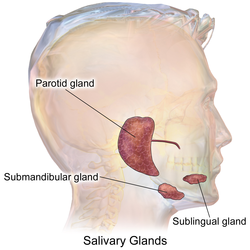Parotid gland
| Parotid gland | |
|---|---|
 |
|
| Details | |
| Artery | transverse facial artery |
| Vein | external jugular vein |
| Nerve |
Glossopharyngeal nerve otic ganglion |
| Lymph | preauricular deep parotid lymph nodes |
| Identifiers | |
| Latin | Glandula parotis or glandula parotidea |
| MeSH | A03.556.500.760.464 |
| Dorlands /Elsevier |
12392553 |
| TA | A05.1.02.003 |
| FMA | 59790 |
|
Anatomical terminology
[]
|
|
The parotid gland is a major salivary gland in many animals. In humans, the two parotid glands are present on either side of the mouth and in front of both ears. They are the largest of the salivary glands. Each parotid is wrapped around the mandibular ramus, and secretes serous saliva through the parotid duct into the mouth, to facilitate mastication and swallowing and to begin the digestion of starches.
The word parotid (paraotic) literally means "beside the ear".
The parotid glands are a pair of mainly serous salivary glands located below and in front of each ear canal, draining their secretions into the vestibule of the mouth through the parotid duct. Each gland lies behind the mandibular ramus and in front of the mastoid process of the temporal bone. The gland can be felt on either side, by feeling in front of each ear, along the cheek, and below the angle of the mandible. The gland is roughly wedge-shaped when seen from the surface.
The parotid duct, a long excretory duct, emerges from the front of each gland, superficial to the masseter muscle. The duct pierces the buccinator muscle, then opens into the mouth on the inner surface of the cheek, usually opposite the maxillary second molar. The parotid papilla is a small elevation of tissue that marks the opening of the parotid duct on the inner surface of the cheek.
The gland has four surfaces — superficial or lateral, superior, anteromedial, and posteromedial. The gland has three borders — anterior, medial, and posterior. The parotid gland has two ends — superior end in the form of small superior surface and an inferior end (apex).
...
Wikipedia
